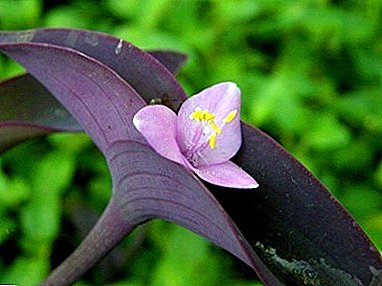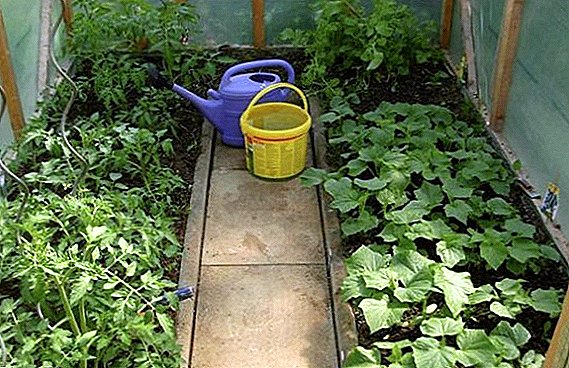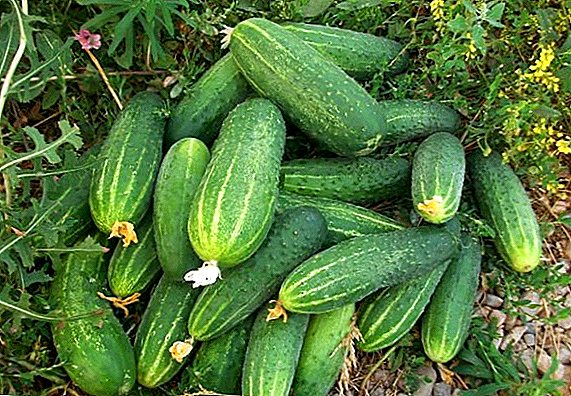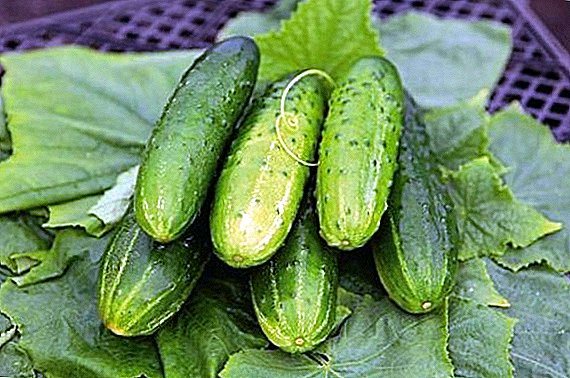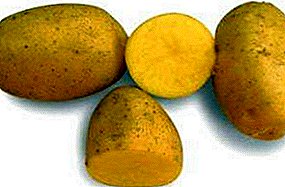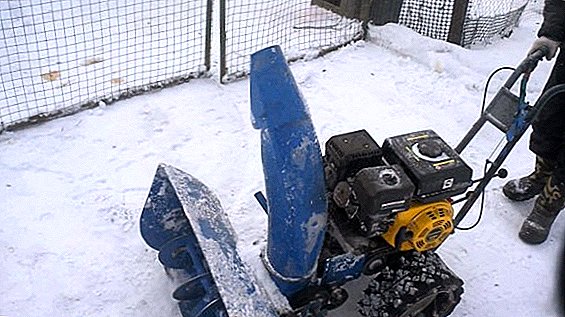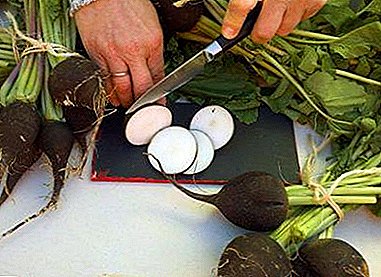
Black radish is an unpretentious frost-resistant culture of root crops, available for growing in any territory and subject to long-term storage.
With proper care, the plant produces large dense fruits with excellent taste, which allows long-term use of roots in cooking for cooking vegetable dishes, as well as in traditional medicine for the prevention and treatment of many diseases.
Further in the article we will talk about how to plant this healthy vegetable and properly care for it, as well as how to protect your crop from pests.
Seeding features
- It is necessary to take into account the temperature regime when sowing seeds. Subzero temperatures cause the plant to be broken.
- Sow seeds soaked to achieve 100% germination. Seeds should be pre-treated with a solution of potassium permanganate to protect against pests.
- Planting can be carried out as a single seed, and nests of 3-5 pieces.
- It is necessary to follow the rules of crop rotation.
- When planting, keep the soil moist.
- The beds at night covered with a protective dark material.
Compatibility with other cultures
Black radish is recommended to plant after:
 potatoes;
potatoes;- garlic;
- Luke;
- pepper;
- melons;
- legumes;
- Solanaceae.
You can not plant black radish after cruciferous crops, because they have common pests and diseases. Re-plant black radish at the same place in 3-4 years.
Recommended neighboring crops for black radish:
- bow;
- potatoes;
- tomatoes
Joint cultivation leads to mutual rejection of pests and slugs.
Sorta
In terms of technical maturity, black radish varieties are divided into 4 types:
- Early small-fruited, ripening period to 40-50 days - "May". Sowing is done in March.
- Early maturityGrowth period up to 50-60 days:
- "Ladushka";
- "Sultan".
- Mid-season, growth up to 75-80 days:
- "Black Winter";
- "Black Round";
- "Chernavka".
Sowing in mid-June or early July.
- Late ripening varietiesVegetation period up to 4 months:
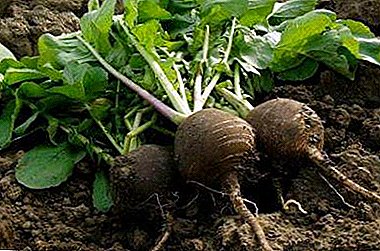 "Gaivoronskaya";
"Gaivoronskaya";- "Squire Black";
- "Black Woman";
- "Doctor".
Sowing is done in mid-July.
Sowing in late April.
When choosing a variety take into account the characteristics of the region. On a territory with a cold climate, early varieties should be preferred, which will have time to rise and ripen before the onset of cold weather. In central Russia and on a territory with a warm climate, any variety is chosen depending on when it is planned to harvest.
Where and for how much can you buy seeds?
In Moscow and St. Petersburg, you can buy seeds in paper bags of 2 grams in stores for growers. You can also order them online. The cost of a bag varies from 6 to 16 rubles and averages 11 rubles excluding delivery.
Where it is better to sow in an open ground and the greenhouse?
To plant black radish in open ground, for example, in the country, you should choose an open solar space, as the plant is light-requiring. Beds at night covered with a dark protective material to avoid strelkovaniya. When planting black radish in greenhouse conditions, you can choose any place of the greenhouse, with a lack of light using fluorescent lamps. The beds close at night is not required.
How to plant: step by step instructions
Timing
When and how to plant black radish depends on the daytime temperature, which should be set at about + 2-3 degrees.
- Early small-fruited varieties are planted in mid-March.
- Early ripening - in late April or early May.
- Mid-season - in the middle of June.
- Late ripening - in the middle of July.
Soil preparation
 The soil should be well drained and heated.covered most of the day. Loamy and sandy loam soil is allowed, as they well retain the necessary moisture. The medium is weakly acid or weakly alkaline, the neutral is optimal. Sour primer needs to be calculated at the rate of 200 grams of lime per 1 square meter.
The soil should be well drained and heated.covered most of the day. Loamy and sandy loam soil is allowed, as they well retain the necessary moisture. The medium is weakly acid or weakly alkaline, the neutral is optimal. Sour primer needs to be calculated at the rate of 200 grams of lime per 1 square meter.
They dig up the earth, make mineral fertilizers based on potassium, superphosphate, urea. Lean soil is additionally fertilized with humus, compost, ash. Manure for black radish is not recommended, as this may affect the taste of the fruit.
Preparation of inventory and seeds
- Black radish seeds are calibrated before planting - pour a concentrated salt solution at the rate of 1 tablespoon per 200 ml of water.
- Floated seeds are removed.
- The settled seeds are dried and sieved through a sieve to calibrate the size: seeds that are not sifted through a sieve should be removed.
- After calibration, the seeds are soaked in wet gauze for maximum germination.
- A day before sowing, seeds are soaked in a solution of potassium permanganate (1: 6000), which has disinfecting properties.
Choosing a place
- Planting in open ground: choose well-lit beds, taking into account the rules of crop rotation, far from cruciferous crops.
- Planting in the greenhouse: To any garden bed that will be well lit most of the day or has fluorescent lamps. Consider neighboring plants.
Scheme and technology
Recommended landing patterns:
- Planting in the greenhouse - pre-prepared pits, placed in a checkerboard pattern. In one hole sown 1 seed.
- In a bed with a width of 0.8-1.0 m. make 4 rows at a distance of 20-25 cm with furrows up to 1.5-2 cm deep. Seeds are sown one by one. The distance between the furrows is at least 15 cm for late varieties, at least 8 cm for early ones. This method is recommended for sowing in open ground.
- Nest landing - 3-5 seeds per well. The distance between the holes to 15 cm. This method is recommended for open ground.
Planting technology:
- on a loosened and leveled bed, seeds are sown according to the above schemes, having previously moistened the ground;
- seeds are sprinkled with earth;
- lightly tamped down;
- pour water;
- after sowing, sprinkle the beds with wood ash.
Shoots appear in a week.
Caring events
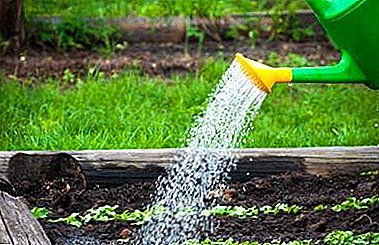 Watering. Watering is carried out in the morning or evening as the top layers of the soil dry. When seedlings emerge, the beds are watered every other day. When the plants reach a height of more than 10 cm, they irrigate the plants: early varieties are watered 1-2 times a week, late ones 1-2 times a month.
Watering. Watering is carried out in the morning or evening as the top layers of the soil dry. When seedlings emerge, the beds are watered every other day. When the plants reach a height of more than 10 cm, they irrigate the plants: early varieties are watered 1-2 times a week, late ones 1-2 times a month.Drying of the soil is not allowed, otherwise the fruits will be bitter and rough. Watering rate: 10 liters of water per 1 square meter. Drip irrigation is allowed.
- Soil loosening. It is carried out to avoid the appearance of crusts on the bed after each watering. This will also prevent the occurrence of weeds.
- Fertilizer. Top dressings enter up to 3 times for growth period. When the seed leaves appear, the first feeding with nitrogen-containing complexes to stimulate growth. Re-fertilizer is administered in a week. The third dressing is carried out in a month with potassium, phosphate fertilizers (superphosphate, urea).
One month before the intended harvesting, feeding is stopped. Organic fertilizers are preferred compost, humus, herbal extracts, wood ash.
- Mulching and hilling. The mulching of the beds is carried out with peat or fine rotted sawdust immediately upon the emergence of shoots, which will preserve the microclimate of the bed, moisture and trace elements of the soil. Hilling is done twice after thinning.
- Thinning. When shoots appear, immediately remove the weakest shoots. The second thinning is carried out when the seedlings will have 3-4 true leaves. Thin out the bed up to a distance of 5 cm between shoots. The third thinning is carried out in a month, leaving up to 15 cm between root crops.
Pest protection
Black radish has the following pests:
- cruciferous flea;
- carrot flies;
- putrid fungi;
- slugs;
- cabbage leaf beetle;
- rapeseed flower eater;
- powdery mildew.
Control measures
Seedling treatment:
- drug "Confidor";
- soap solution;
- infusion of celandine;
- wood ash solution;
- tobacco dust;
- a weak solution of vinegar;
- drugs "Intravir", "Fitoverm", "Lipocid".
Possible problems and difficulties
 Planting dry seeds.
Planting dry seeds.At the same time, seed germination is significantly reduced. Corrective measures: soil support in the wet state, bed cover with protective material.
- Planting Untreated Seeds - leads to infection of seedlings by pests.
When the first signs of the disease appear, the plants are treated with a 1% solution of boric acid, bordeaux liquid, copper sulphate.
- Small fruits.
Cultivation of crops requires a slight rocking of the root, which helps prevent the development of lateral shoots of the roots, resulting in the fruit grows large and dense.
- Shooting.
Radish is prone to the formation of arrows with insufficient care, the main reason is cold. To avoid this, it is necessary to constantly maintain the soil in a wet state, cover the beds with a film, to prevent thickening of the beds (regular thinning).
- Cracking root crops.
Occurs in violation of irrigation, when the soil remains dry for a long time. In order to avoid cracking the soil is constantly kept in a moist condition.
- Premature bloom.
Inadequate thinning contributes to its development, then the ground part of the plant begins to increase. Prevention - the proper thinning of a specially developed scheme.
Black radish is a cold-resistant plant with rich strong roots, which are grown in open ground and in the greenhouse with minimal care conditions. The unpretentiousness of the plant allows you to get a large crop to be stored and used in cooking, animal husbandry and medicine for a whole year.


 potatoes;
potatoes; "Gaivoronskaya";
"Gaivoronskaya"; Watering. Watering is carried out in the morning or evening as the top layers of the soil dry. When seedlings emerge, the beds are watered every other day. When the plants reach a height of more than 10 cm, they irrigate the plants: early varieties are watered 1-2 times a week, late ones 1-2 times a month.
Watering. Watering is carried out in the morning or evening as the top layers of the soil dry. When seedlings emerge, the beds are watered every other day. When the plants reach a height of more than 10 cm, they irrigate the plants: early varieties are watered 1-2 times a week, late ones 1-2 times a month. Planting dry seeds.
Planting dry seeds.